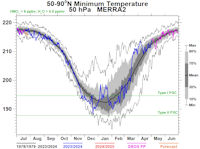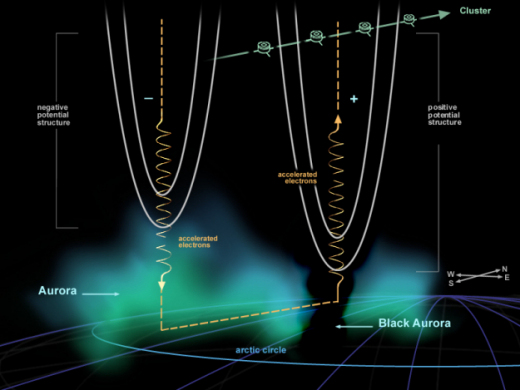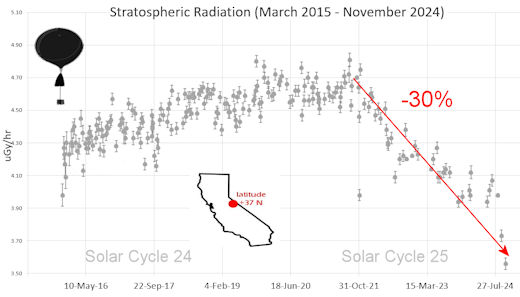 | | | Switch to: Europe, USA, New Zealand, Antarctica Credit: NOAA/Ovation  Planetary K-index Planetary K-index
Now: Kp= 1.00 quiet
24-hr max: Kp= 2.00 quiet
explanation | more data
Interplanetary Mag. Field
Btotal: 4.88 nT
Bz: 0.33 nT north
more data: ACE, DSCOVR
Updated: Today at 1147 UT  Coronal Holes: 27 Nov 24 Coronal Holes: 27 Nov 24 
There are no significant equatorial coronal holes on the Earthside of the sun. Credit: SDO/AIA  Polar Stratospheric Clouds
Colorful Type II polar stratospheric clouds (PSC) form when the temperature in the stratosphere drops to a staggeringly low -85C. NASA's MERRA-2 climate model predicts when the air up there is cold enough: 
On Nov. 27, 2024, the Arctic stratosphere is cold enough for Type I polar stratospheric clouds, but Type II clouds are still almost 10 degrees away. Additional cooling is required. | more data. Noctilucent Clouds
The southern season for noctilucent clouds (NLCs) is underway!. The first clouds were detected over Antarctica on Nov. 19, 2024. Here is the current NLC map from the NOAA 21 satellite.

Updated: Nov. 26, 2024
An instrument onboard NOAA 21 (OMPS LP) is able to detect NLCs (also known as "polar mesospheric clouds" or PMCs). In the daily map, above, each dot is a detected cloud. As the season progresses, these dots will multiply in number and shift in hue from blue to red as the brightness of the clouds intensifies.
 SPACE WEATHER
NOAA Forecasts | | Updated at: 2024 Nov 27 2200 UTC FLARE | 0-24 hr | 24-48 hr | CLASS M | 65 % | 65 % | CLASS X | 20 % | 20 % |  Geomagnetic Storms: Geomagnetic Storms:
Probabilities for significant disturbances in Earth's magnetic field are given for three activity levels: active, minor storm, severe storm Updated at: 2024 Nov 27 2200 UTC Mid-latitudes | 0-24 hr | 24-48 hr | ACTIVE | 40 % | 30 % | MINOR | 20 % | 35 % | SEVERE | 05 % | 20 % | High latitudes | 0-24 hr | 24-48 hr | ACTIVE | 10 % | 05 % | MINOR | 25 % | 20 % | SEVERE | 60 % | 70 % | | | |  | | | | | | | | | | | This is an AI Free Zone! Text created by Large Language Models is spreading rapidly across the Internet. It's well-written, artificial, frequently inaccurate. If you find a mistake on Spaceweather.com, rest assured it was made by a real human being. | | | THANKSGIVING GEOMAGNETIC STORM WATCH: A G2-class geomagnetic storm is possible on Nov. 28-29 when a CME is expected to hit Earth's magnetic field. The CME was hurled into space by a magnetic filament attached to sunspot 3901, which erupted on Nov. 25th. There is a chance this CME will sail south of Earth with little to no contact, so this is a low probability forecast. CME impact alerts: SMS Text BLACK AURORAS OVER ALASKA? Todd Salat is a veteran photographer of auroras in Alaska. For years he has chased the lights and seen most of what Mother Nature has to offer. But even he was puzzled on Nov. 22nd when these strangely-shaped auroras appeared overhead: 
"I saw these bizarre auroras drift over southcentral Alaska around 4 am last Friday morning," says Salat. "It came up from the northwest and I was like, whoa! It looked like the letter E to me." Salat may have witnessed an episode of 'black auroras.' They are dark rings or black blobs that sometimes appear in an otherwise ordinary expanse of auroral light. For example, look at Figure 1 in this research paper on the topic. Some researchers call them "anti-auroras." The black auroras in Salat's photo are circled here. Ordinary auroras are caused by electrons raining down from space. Black auroras are the opposite. Instead of electrons raining down, electrons are propelled upwards back into space. Europe's fleet of Cluster spacecraft flew over a black aurora on Jan. 14, 2001, and saw the process in action: 
Sensors onboard the spaceraft detected strong positive electric fields in the black aurora zone. These fields reversed the normal downward rain of aurora-causing electrons. The study of black auroras is still in its infancy, and forecasters cannot yet predict when or where they might appear. Aurora watchers, the next time a geomagnetic storm erupts, be alert for black. Aurora alerts: SMS Text. Realtime Space Weather Photo Gallery
Free: Spaceweather.com Newsletter BLACK FRIDAY AT THE EDGE OF SPACE: Christmas is coming. Are you looking for a far-out gift? Check out the Earth to Sky Store. It's filled with unique items that have flown to the edge of space onboard cosmic ray research balloons.

Carried aloft by giant helium balloons, these unique gifts have flown above 99.7% of Earth's atmosphere, experiencing space-like blasts of cosmic rays, extreme cold, and a wild ride parachuting back to Earth after the balloon explodes. Even Amazon doesn't carry items this far out. Don't forget to enter coupon code "BLACKCAT" at checkout for a 10% holiday discount. Far Out Gifts: Earth to Sky Store
All sales support hands-on STEM education
Realtime Comet Photo Gallery
Free: Spaceweather.com Newsletter
Realtime Aurora Photo Gallery
Free: Spaceweather.com Newsletter Every night, a network of NASA all-sky cameras scans the skies above the United States for meteoritic fireballs. Automated software maintained by NASA's Meteoroid Environment Office calculates their orbits, velocity, penetration depth in Earth's atmosphere and many other characteristics. Daily results are presented here on Spaceweather.com. On Nov 27, 2024, the network reported 5 fireballs.
(4 sporadics, 1 November omega Orionid)  In this diagram of the inner solar system, all of the fireball orbits intersect at a single point--Earth. The orbits are color-coded by velocity, from slow (red) to fast (blue). [Larger image] [movies] Potentially Hazardous Asteroids ( PHAs) are space rocks larger than approximately 100m that can come closer to Earth than 0.05 AU. None of the known PHAs is on a collision course with our planet, although astronomers are finding new ones all the time. On November 27, 2024 there were 2349 potentially hazardous asteroids.
 | Recent & Upcoming Earth-asteroid encounters: | Asteroid | Date(UT) | Miss Distance | Velocity (km/s) | Diameter (m) | | 2024 WV | 2024-Nov-22 | 7.7 LD | 6.1 | 19 | | 2024 WY | 2024-Nov-23 | 14.6 LD | 9.4 | 32 | | 2024 WE | 2024-Nov-23 | 2.7 LD | 2.7 | 9 | | 2024 VY2 | 2024-Nov-24 | 16.3 LD | 13.2 | 53 | | 2024 WM3 | 2024-Nov-24 | 1.8 LD | 8.9 | 16 | | 2024 WP1 | 2024-Nov-24 | 0.3 LD | 16 | 9 | | 2024 WU | 2024-Nov-24 | 7.9 LD | 8.1 | 19 | | 2024 WW2 | 2024-Nov-24 | 0.9 LD | 9.8 | 7 | | 2024 WK | 2024-Nov-24 | 4.6 LD | 11 | 20 | | 2024 WV1 | 2024-Nov-24 | 0.5 LD | 9.6 | 5 | | 2009 WB105 | 2024-Nov-25 | 15.1 LD | 18.9 | 71 | | 2024 WK4 | 2024-Nov-25 | 3 LD | 7.6 | 6 | | 2024 WF2 | 2024-Nov-25 | 7.5 LD | 6.6 | 10 | | 2024 WJ3 | 2024-Nov-25 | 11.7 LD | 5.3 | 9 | | 2006 WB | 2024-Nov-26 | 2.3 LD | 4.2 | 98 | | 2024 WD3 | 2024-Nov-27 | 4.5 LD | 5.4 | 8 | | 2024 WQ2 | 2024-Nov-27 | 5.4 LD | 17.3 | 42 | | 2024 WL4 | 2024-Nov-27 | 13.2 LD | 6.8 | 13 | | 2024 WS3 | 2024-Nov-27 | 8.1 LD | 7.9 | 27 | | 2024 WF3 | 2024-Nov-28 | 10.9 LD | 6.9 | 12 | | 2024 WT3 | 2024-Nov-28 | 6.2 LD | 11.1 | 11 | | 2024 WT | 2024-Nov-28 | 2.3 LD | 3.8 | 13 | | 2018 DC4 | 2024-Nov-29 | 18.8 LD | 4.5 | 12 | | 2024 WZ | 2024-Nov-29 | 3.8 LD | 9.9 | 14 | | 2019 JN2 | 2024-Nov-30 | 9.4 LD | 7.7 | 25 | | 2024 WS | 2024-Nov-30 | 6.1 LD | 10.5 | 18 | | 2024 WN4 | 2024-Dec-02 | 4.6 LD | 11.5 | 14 | | 2021 XZ | 2024-Dec-02 | 13.2 LD | 7.4 | 8 | | 447755 | 2024-Dec-03 | 14.4 LD | 12.2 | 402 | | 2020 XR | 2024-Dec-04 | 5.8 LD | 12.3 | 388 | | 2024 WO1 | 2024-Dec-04 | 11.7 LD | 4.3 | 14 | | 2021 WA5 | 2024-Dec-05 | 9.8 LD | 5.9 | 12 | | 2024 WB1 | 2024-Dec-05 | 19.1 LD | 5.8 | 25 | | 2024 WG3 | 2024-Dec-07 | 18.4 LD | 6.5 | 40 | | 2024 UU3 | 2024-Dec-08 | 16.9 LD | 4.8 | 38 | | 2018 XU3 | 2024-Dec-11 | 16.8 LD | 10.8 | 28 | | 2007 XB23 | 2024-Dec-11 | 1.2 LD | 4.8 | 14 | | 2024 VE7 | 2024-Dec-17 | 7.3 LD | 8 | 49 | | 2022 YO1 | 2024-Dec-17 | 2 LD | 14.3 | 4 | | 2020 XY4 | 2024-Dec-19 | 12.8 LD | 8.8 | 14 | | 2017 YD2 | 2024-Dec-27 | 18 LD | 9.9 | 6 | | 2024 AV2 | 2024-Dec-31 | 6.7 LD | 7.8 | 17 | | 2021 AO4 | 2025-Jan-04 | 6.9 LD | 15.1 | 11 | | 2020 BC6 | 2025-Jan-05 | 9.6 LD | 22.2 | 248 | | 2024 BM1 | 2025-Jan-08 | 11.5 LD | 9.1 | 22 | | 2024 PT5 | 2025-Jan-09 | 4.7 LD | 1 | 12 | | 2023 OS3 | 2025-Jan-09 | 19.9 LD | 3.1 | 10 | | 2012 UK171 | 2025-Jan-11 | 10.7 LD | 6.4 | 46 | | 2023 OS | 2025-Jan-15 | 16.6 LD | 10.9 | 48 | | 2022 CE2 | 2025-Jan-16 | 11.1 LD | 13.3 | 120 | | 2022 OB5 | 2025-Jan-18 | 8.9 LD | 1.4 | 6 | Notes: LD means "Lunar Distance." 1 LD = 384,401 km, the distance between Earth and the Moon. 1 LD also equals 0.00256 AU. | | Cosmic Rays in the Atmosphere | SPACE WEATHER BALLOON DATA: Almost once a week, Spaceweather.com and the students of Earth to Sky Calculus fly space weather balloons to the stratosphere over California. These balloons are equipped with sensors that detect secondary cosmic rays, a form of radiation from space that can penetrate all the way down to Earth's surface. Our monitoring program has been underway without interruption for 10 years, resulting in a unique dataset of in situ atmospheric measurements. Latest results (Nov. 2024): Atmospheric radiation is decreasing in 2024. Our latest measurements in November registered a 10-year low: 
What's going on? Ironically, the radiation drop is caused by increasing solar activity. Solar Cycle 25 has roared to life faster than forecasters expected. The sun's strengthening and increasingly tangled magnetic field repels cosmic rays from deep space. In addition, solar coronal mass ejections (CMEs) sweep aside cosmic rays, causing sharp reductions called "Forbush Decreases." The two effects blend together to bring daily radiation levels down. .Who cares? Cosmic rays are a surprisingly "down to Earth" form of space weather. They can alter the chemistry of the atmosphere, trigger lightning, and penetrate commercial airplanes. According to a study from the Harvard T.H. Chan school of public health, crews of aircraft have higher rates of cancer than the general population. The researchers listed cosmic rays, irregular sleep habits, and chemical contaminants as leading risk factors. A number of controversial studies (#1, #2, #3, #4) go even further, linking cosmic rays with cardiac arrhythmias and sudden cardiac death. Technical notes: The radiation sensors onboard our helium balloons detect X-rays and gamma-rays in the energy range 10 keV to 20 MeV. These energies span the range of medical X-ray machines and airport security scanners. Data points in the graph labeled "Stratospheric Radiation" correspond to the peak of the Regener-Pfotzer maximum, which lies about 67,000 feet above central California. When cosmic rays crash into Earth's atmosphere, they produce a spray of secondary particles that is most intense at the entrance to the stratosphere. Physicists Eric Regener and Georg Pfotzer discovered the maximum using balloons in the 1930s and it is what we are measuring today. | | The official U.S. government space weather bureau | | | The first place to look for information about sundogs, pillars, rainbows and related phenomena. | | | Researchers call it a "Hubble for the sun." SDO is the most advanced solar observatory ever. | | | 3D views of the sun from NASA's Solar and Terrestrial Relations Observatory | | | Realtime and archival images of the Sun from SOHO. | | | information about sunspots based on the latest NOAA/USAF Active Region Summary | | | current counts of failed and deployed Starlink satellites from Jonathan's Space Page. See also, all satellite statistics. | | | Authoritative predictions of space junk and satellite re-entries | | | from the NOAA Space Environment Center | | | fun to read, but should be taken with a grain of salt! Forecasts looking ahead more than a few days are often wrong. | | | from the NOAA Space Environment Center | | | the underlying science of space weather |  | Got a chipped or cracked windshield that prevents you from seeing space weather events while driving? Get windshield replacement from SR Windows & Glass with free mobile auto glass service anywhere in the Phoenix area. |  | BestCSGOGambling is the best site for everything related to CSGO gambling on the web | | | These links help Spaceweather.com stay online. Thank you to our supporters! | | | | | | | | |  | |  |   | ©2021 Spaceweather.com. All rights reserved. This site is penned daily by Dr. Tony Phillips. | |

